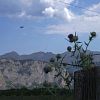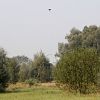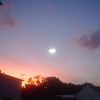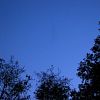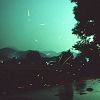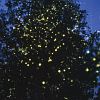Just like birds that happen to pass in front of a camera lens when a picture is snapped, insects too can cause photographers to think that they captured an extraordinary alien vehicle, invisible to the naked eye but not to a camera. This may happen in the day (with winged insects such as flies and bees showing up like blurred dark spots) or at night (when insects, especially moths, are illuminated by the light of a camera flash).
While in reality solitary insects almost never cause visual sightings, swarms of insects do, both in daylight and during the night.
When the air is warm and there's little wind, mosquitoes sometimes have a strange habbit of grouping over marked landscape features such as treetops and church steeples. The result is something that looks like a cloud of black smoke, usually in the shape of a narrow, vertical pillar some 2 to 5 m (6 to 16 feet) high and 20 to 40 cm (8 to 16 inches) wide. The reason why these tiny critters gather by the hundreds in pillar-shaped formations is to enhance their chances of meeting a partner (not longer than 50 years ago, it was still believed that these "convection plumes" were the result of a hitherto unknown physical/chemical process). Usually, insect clouds form just before darkness sets in. However, some reports exist in which the clouds were spotted at night over puddles and swamps. When illuminated by car headlights or a full moon, a casual observer will easily be misled.
An article in Applied Optics (issue of November 1, 1978) examined the possibility of night flying moths as an explanation for a wave of UFO reports that flooded the Uintah Basin area in Utah, U.S., in the mid 1960s. The authors postulated that some of the luminous phenomena observed over the bassin were due to mass swarms of spruce budworms "flying into high electric fields caused by thunderheads and high density particulate matter in the air". They found that, when subjected to electric fields, the moths produce light similar to Saint Elmo's fire (a bluish light that sometimes discharges from pointed structures such as church towers and ship masts).
Other insects, like the firefly (actually not a fly, but a beetle), can produce light because of a chemical process inside their own bodies, a feature called bioluminescence. Fireflies (aka glow worms or lightning bugs) do, on occasion, cause people to report strange flashing lights in their back garden. During the mating season specific species of fireflies group together in trees or in shrubs and hedgerows, sometimes flashing in unison. The colours emitted by the beetles are green, yellow, orange and amber.
